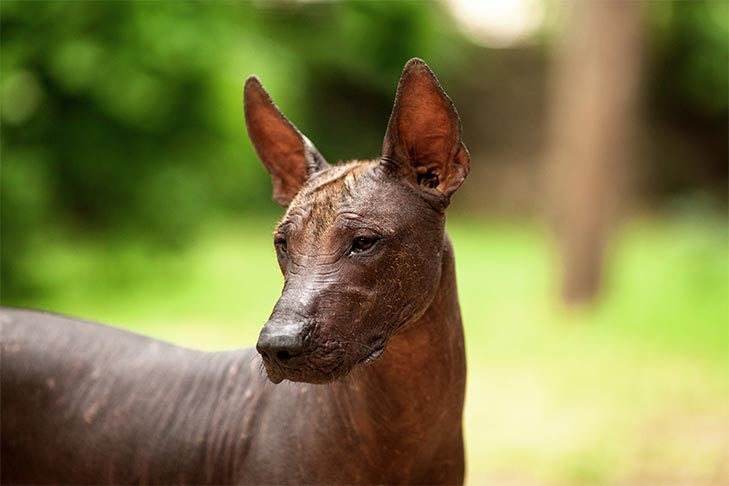
Even if you haven’t heard of the Xolo (pronounced “show-low”), you’ve likely seen one of these unusual dogs at some point. The Aztecs considered the Xolo sacred, and invested them with mystical healing abilities. The breed’s full name, Xoloitzcuintli, derives from the name of the Aztec god of fire and lightning, Xolotl, as well as “itzcuintli,” the Aztec word for dog. They are also referred to as “Mexican hairless dogs.”
Here’s everything else you need to know about Mexico’s national dog, the Xoloitzcuintli.
1. They’re the Oldest Dogs in the Americas
Xolos have been around for at least 3,000 years. Archaeological evidence suggests they accompanied the first humans to cross the Bering Strait, then lived in the jungles of Mexico, where they were prized by ancient cultures. Later, European colonizers, including Christopher Columbus, wrote about them in their journals, describing them as “strange, hairless dogs.”
2. The Breed’s Three Distinct Size Varieties Are Toy, Miniature, and Standard
According to the AKC breed standard, the Standard Xolo can measure up to two feet tall at the shoulder, while the miniature is typically between a foot and a foot-and-a-half, and the toy is around a foot or less. With such variation, the Xolo is a versatile breed.
3. Though Typically Hairless, They Do Come in a Coated Variety
While Xolos are famously free of hair, there are actually two varieties—hairless and coated. The hairless variety has a tough hide that protects the dog well from scrapes and scratches and may have a few coarse hairs on the head, tail, and feet. Conversely, the coated Xolo has a very short, sleek coat all over the body.
4. Xolos Require a Serious Skincare Routine
Since their skin produces oils, Xolos can get acne, especially in their first year of life. Skincare advice varies, but a good rule of thumb is to keep the Xolo clean by wiping them down with a damp cloth to remove dead skin cells and bathing—though bathing too frequently will strip the natural oils and could end up clogging the pores more. Using a light moisturizer after bathing helps, and since they’re hairless, Xolos should wear canine sunscreen during prolonged periods in the sun.
5. They’ll Do Fine With Moderate Amounts of Exercise
All dogs need exercise, and Xolo puppies especially should get lots of playtime and at least one long walk every day, to keep any destructive behaviors in check. In particular, the Xolo has a strong prey drive, which can be tempered by sufficient exercise. That being said, Xolos don’t need to run for miles every day like some more active breeds.
6. A Small Apartment Is Big Enough for a Xolo
The Xolo loves a good walk, but doesn’t necessarily need a yard to run around. When they’re at home, they’re known for their calm and tranquility.
7. Suitable as Watchdogs, Xolos Don’t Make Great Guard Dogs
The Aztecs believed the Xolo could protect a house from evil spirits as well as human intruders. These dogs will speak up and let you know if anyone comes to the house — but since they can be reserved with strangers, don’t expect them to frighten off any intruders.
8. They Thrive as Pack Animals
Known for their loyalty, Xolos will often bond with one member of the family in particular, but everyone in the family will feel their warmth — including other dogs, whom they like to have around. They might be a little more reserved with strangers, but not typically aggressive.
9. People With Dog Allergies Often Have No Issues With Xolos
Though Xolos still have some common irritants—namely saliva, skin, and some hair—many people who suffer from dog allergies find that they don’t have a problem with Xolos. However, this is far from universal, and allergy sufferers interested in Xolos should spend some time with one before committing, to see how they may react.
10. The Xoloitzcuintli Is Typically a Robust, Healthy Breed
Thanks in part to their hardy origins in ancient jungles, Xolos are an overall healthy breed. The Xolo Club of America does recommend hip, ophthalmologist, cardiac, and patella (kneecap) tests, and reputable breeders should be able to show proof of such tests for your puppy’s parents. But for the most part, a Xolo that receives good food and exercise should have minimal health problems.